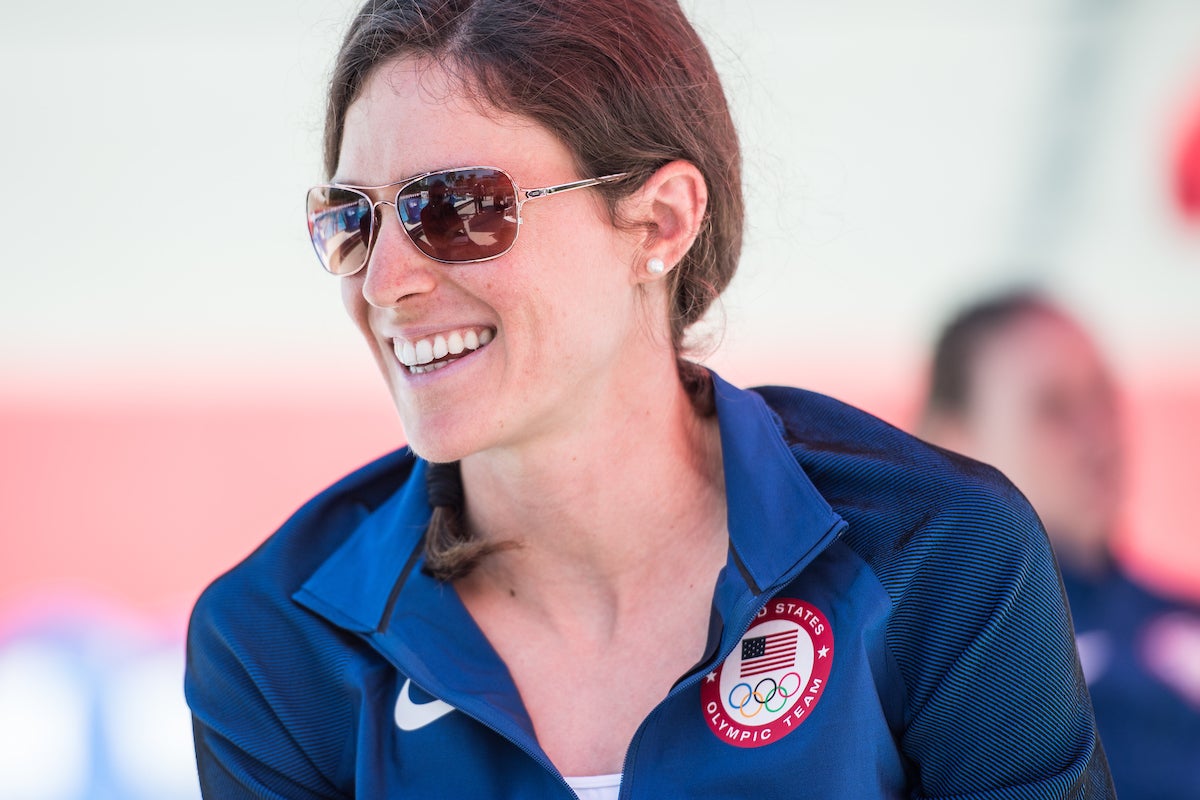6 Keys To Gwen Jorgensen’s Success

Jorgensen chats with the media before the 2016 Rio Olympics. Photo: Nils Nilsen/USA Triathlon
The medal contender on building confidence, and making smart choices to prep for the Olympic race of her life
It’s no secret that American Gwen Jorgensen is a heavy favorite going into tomorrow’s Olympic triathlon in Rio, but in case you’re playing catch-up, here’s what she’s accomplished in the past few years: 17 ITU World Triathlon Series wins since April 2013, with an unprecedented winning streak from May 2014 to April 2015 that included back-to-back world titles and a win at the Rio test event last August.
Jorgensen’s dominance has a lot to do with executing smart tactics and using her strongest leg—the run—to leave competitors in her wake, but there’s a lot more to her success than just swimming, biking and running as fast as she can. Plus, with every athlete at the top of her game on Olympics day, Jorgensen knows it will take a lot to earn gold.
“Every race is completely different and that’s something I like about this sport,” Jorgensen says. “You go into the triathlon and you have no idea what can happen on race day, and you have to be prepared for anything. I think that really makes it a hard race, but also makes it exciting to watch. Every race is different and the Olympics is even more different, but it’s something we try to prepare for, and have as many weapons in our tool bag as possible.”
RELATED – Gwen Jorgensen On Rio: “Ready To Give It My Everything”
To prepare, here are six things Jorgensen used to set herself up for success going into her second Olympic Games.
Fully committing. Since her Olympic debut in London (where she suffered a flat and ultimately finished 38th), Jorgensen has fully embraced the necessity of training full-time with her coach Jamie Turner and a squad—which meant leaving her comfort zone in the U.S. for Australia and Spain. “Being away from home was a difficult transition and something I was hesitant to do for a long time,” she says. “I didn’t want to go abroad and I’m from the Midwest—I like being around my friends and family. The biggest thing that changed for me was that my coach said that it’s an investment, not a sacrifice, to be away from home. That mindset shift has been vital.”
Starting the year slowly. Rather than stocking her schedule full of races all over the world, Jorgensen and her coach decided to only do races near their base in the Basque region of Spain. She also didn’t start doing race-specific speed work until closer to the Games. “It’s nice to come here and not have had a bunch of long-haul travel,” she says. “Long travel, at least for me, can wear down the body. I only went to ITU races that were geographically close to me.”
Documenting. Every day, Jorgensen writes down three things she does well and three things she could improve upon. “If I need confidence, I look back on those three things I do well and that’s what gives me confidence going into a race.” She also does a race report after every event to help capture each element to help in the future. “I go through what I was thinking on the swim, the bike and the run, and that’s something I look at with both the USAT High Performance team and my coach, and I analyze it to see if there are changes I can make to improve.”
Practicing the small things. Jorgensen says that she crafted her lifestyle around her Rio goal for the past four years—everything from training to sleeping to eating has been a conscious choice. Outside of those important elements, she also doesn’t neglect the small stuff that’s also a part of racing. “Transitions are often overlooked, and it’s something I practice,” she says. “Once a week, I get out in a parking lot and practice putting on my shoes, hopping on my bike, and doing the little things you do in a race.”
Using visualization. “For Rio, I have a virtual reality tool where I can see the course on eyewear, which has been useful to help visualize,” she says. “Then on the day of the race, it’s just being confident. I don’t do anything on the start line except for focus a few key processes I want to execute on my first few strokes—keep my head down and have a high stroke rate.”
Taking advantage of her emotional support system. Although a lot of her confidence comes from her training, Jorgensen says, “I have a really good support team around me that has kept me grounded. You can only do so much on race day. Thankfully I have my coach Jamie and husband Patrick to help get me there.”
“Patrick is here first and foremost as emotional support and that’s what I see as his biggest asset for me. Just being there after a workout or when it’s a recovery day and I don’t feel like doing anything to do with triathlon. He also helps by doing all the cooking, cleaning, takes care of my bike, all the little things so that all I have to focus on is training and resting, and that’s made a huge difference in keeping me recovered and going throughout the season.”